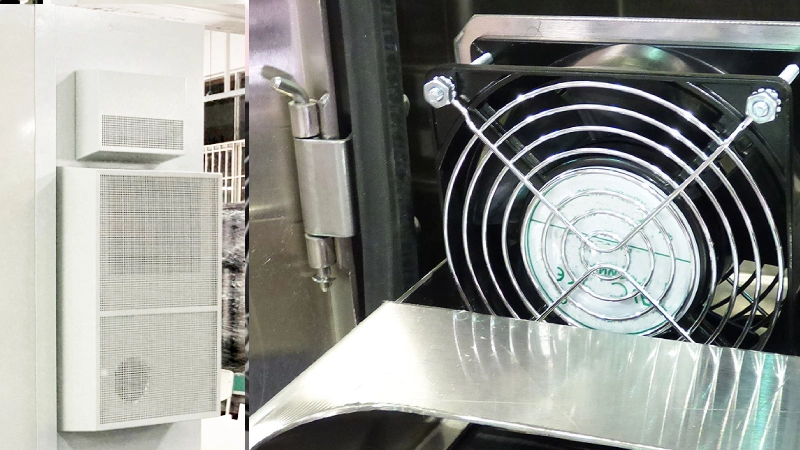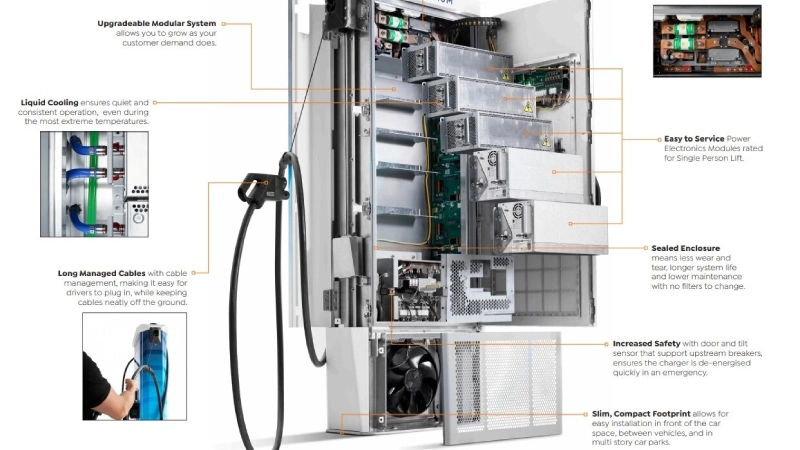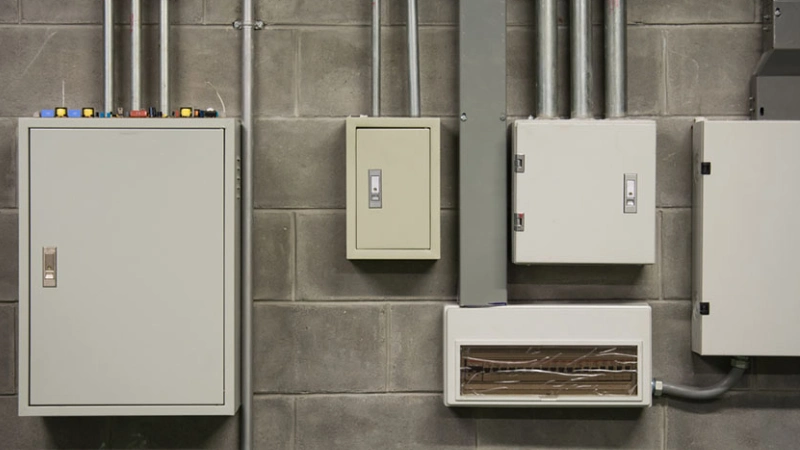In the world of electrical connections, both terminal blocks and terminal strips serve to organize wiring, but they are not interchangeable. While often confused, understanding their distinct features and applications is crucial for effective circuit design and reliable installations.
This blog will delve into the fundamental differences between terminal blocks and terminal strips, exploring their construction, capabilities, and ideal use cases to help you make an informed decision for your specific wiring needs in Japan.
What is a Terminal Block

A terminal block is a modular, insulated electrical connector designed to secure and organize two or more wires within a circuit. It consists of an insulating body with a current-carrying element and a clamping mechanism (like a screw, spring, or push-in) to terminate wires.
Terminal blocks provide a safe, convenient, and highly organized method for connecting and disconnecting individual wires, simplifying wiring layouts, and facilitating maintenance and troubleshooting in various electrical and electronic systems.
Recommended Terminal Blocks
What is a Terminal Strip
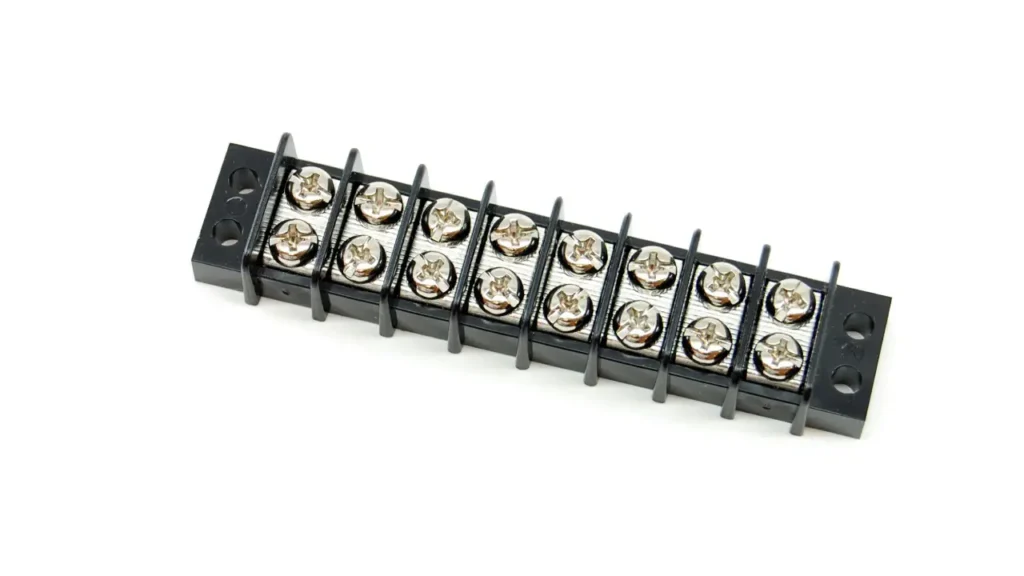
A terminal strip, often referred to as a barrier strip or screw terminal block, is an electrical connector designed to simplify and organize wire connections. It typically consists of a long, insulated base with multiple individual screw terminals arranged in a row.
Each terminal provides a point where one or more wires can be securely fastened, creating a convenient method for connecting and interconnecting circuits, especially in applications where a simple, fixed array of connections is needed without the modularity or specialized features of more advanced terminal blocks.
Terminal Block vs Terminal Strip
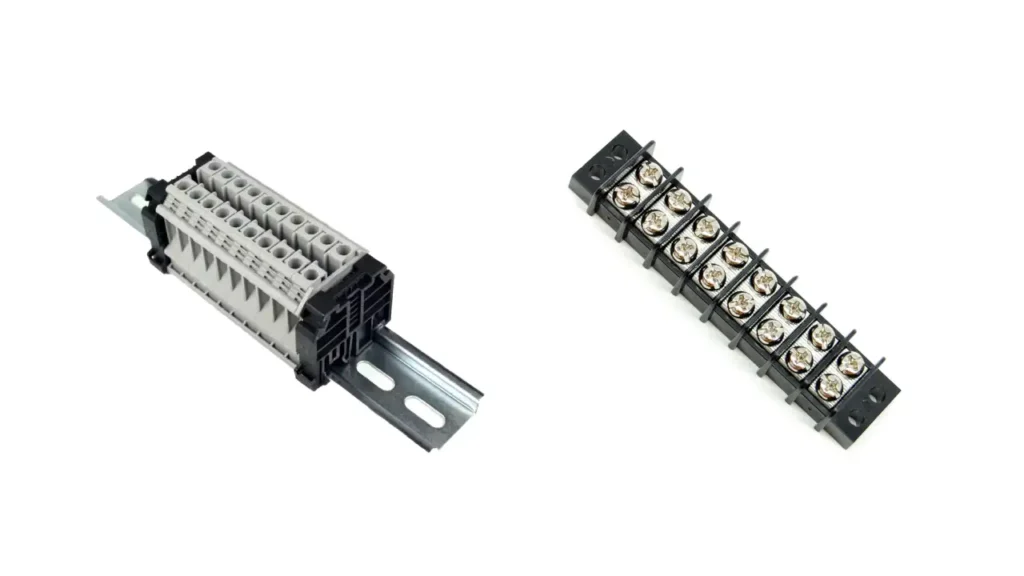
Choosing the right electrical connector is vital for circuit integrity and safety. While both terminal blocks and terminal strips serve to connect wires, they differ significantly in design, functionality, and application suitability. Understanding these distinctions ensures optimal performance, ease of maintenance, and compliance with project requirements.
This comparison will detail their core features, the benefits each offers, their respective pros and cons, and their typical applications, providing a clear guide for making informed decisions in your wiring projects.
Modularity/Structure
Terminal blocks are characterized by their modular design, often as individual units that can be snapped together on a DIN rail to form a continuous strip. This modularity allows for flexible configurations, easy expansion, and the integration of various specialized functions like fusing or disconnecting within the same assembly. Each block typically provides distinct, insulated connection points.
Terminal strips, conversely, are generally manufactured as a single, fixed piece containing a predetermined number of connection points arranged in a row. They usually consist of a basic insulating base with metal terminals, most commonly screw-down types. Their fixed structure offers less flexibility for customization or expansion compared to the modularity of terminal blocks.
Features
Terminal blocks offer a wide array of features, including diverse clamping technologies such as screw, spring, or push-in connections, catering to different wiring preferences and environmental conditions. Many types incorporate specialized functions like built-in fuse holders, disconnect levers, or dedicated grounding connections, enhancing circuit protection and operational safety. They also support various accessories like jumpers, markers, and end plates for organization.
Terminal strips typically feature simpler, often screw-down connections, providing a straightforward method for wire termination. While some may include basic barriers between terminals for insulation, they generally lack the advanced integrated functionalities of terminal blocks, such as fusing, multi-level connections, or specialized sensor wiring capabilities. Their design prioritizes simplicity and cost-effectiveness for basic wire junctions.
Benefits
Terminal blocks provide significant benefits in terms of organization, safety, and ease of maintenance. Their structured layout and clear labeling options simplify complex wiring diagrams, making troubleshooting faster and more efficient. The enhanced insulation and specialized functions contribute to a safer electrical environment, reducing the risk of shorts and improving system reliability through dedicated protection.
Terminal strips offer the primary benefits of being cost-effective and straightforward for basic wire connections. They are easy to install and provide a neat way to terminate multiple wires in a fixed setup. For applications where complex functionality or frequent modifications are not required, terminal strips offer a simple and economical solution for creating reliable electrical junctions.
Pros & Cons
Terminal block pros include high versatility, robust construction for demanding environments, superior safety features through individual insulation and specialized functions, and excellent adaptability for future circuit modifications or expansions. However, their cons can involve a higher cost per connection point and potentially more complex installation for intricate configurations.
Terminal strip pros lie in their economy, simplicity of use, and suitability for fixed wiring applications where a basic connection point is sufficient. Their cons include limited functionality, less adaptability to circuit changes, and generally fewer integrated safety features compared to terminal blocks. They might also be less resilient to vibration or harsh environments without additional protection.
Applications
Terminal blocks are widely utilized in industrial control panels, automation systems, building management systems, and any application requiring organized, flexible, and feature-rich wire termination. They are ideal for managing control signals, power distribution in complex machinery, and applications demanding high levels of safety and ease of troubleshooting.
Terminal strips are commonly found in simpler electrical installations, such as appliance wiring, lighting circuits, basic power distribution in residential or commercial buildings, and general-purpose junction boxes. They are well-suited for projects where the wiring configuration is fixed, the current requirements are moderate, and cost-effectiveness is a primary concern.
Here’s a comparison table summarizing the differences between terminal blocks and terminal strips:
| Feature/Aspect | Terminal Block | Terminal Strip |
|---|---|---|
| Structure | Modular, individual units (often DIN-rail mountable) | Single, fixed piece with multiple terminals in a row (often barrier-type) |
| Modularity | High; easily expanded, reconfigured, or combined with specialized types | Low; fixed number of terminals, less adaptable for changes or additions |
| Features | Diverse clamping types (screw, spring, push-in), specialized functions (fuse, disconnect, grounding), accessories | Primarily screw-down connections, basic wire termination, may have insulation barriers between terminals |
| Safety | Enhanced electrical isolation, often with higher voltage/current ratings, specialized safety features | Basic insulation, relies more on external enclosures for comprehensive safety; ratings can be lower |
| Cost | Generally higher per connection point, but offers more features and flexibility | More economical for basic connections, often chosen for cost-sensitive projects |
| Application Suitability | Complex control systems, industrial automation, precise signal wiring, applications needing modularity & features | Simple electrical wiring, appliance hook-ups, lighting circuits, basic power distribution where fixed, straightforward connections are sufficient |
| Ease of Maintenance | High; individual circuits easily isolated, identified, and worked on | Moderate; involves loosening screws for each connection, less intuitive for complex troubleshooting; harder to modify layout |
How to Choose Terminal Block and Terminal Strip
Choosing between a terminal block and a terminal strip, or selecting the right specific type of each, hinges on a careful assessment of your project’s electrical, environmental, and functional needs. Making the optimal choice ensures safety, system reliability, and streamlines installation and maintenance processes, ultimately impacting the overall cost and longevity of your electrical design.
- Application Complexity & Functionality: For complex control circuits, industrial automation, or applications requiring specialized features like fusing, disconnection, or multi-level connections, a terminal block offers superior functionality and organization. For simple, fixed wire junctions in basic circuits, a terminal strip is usually sufficient and more economical.
- Current & Voltage Ratings: Always ensure the chosen component’s electrical ratings (current, voltage, wire gauge compatibility) meet or exceed your circuit’s maximum requirements to prevent overheating and ensure safety. Both types come in various ratings, so verify specifications.
- Modularity & Flexibility: If future circuit modifications, expansions, or frequent troubleshooting are anticipated, the modularity and accessory options of terminal blocks make them highly advantageous. Terminal strips are less flexible for changes once installed.
- Environmental Conditions: Consider factors like temperature, humidity, vibration, and exposure to dust or chemicals. Terminal blocks often offer more robust constructions and specialized designs (e.g., higher IP ratings, vibration-resistant clamping) for harsh environments than standard terminal strips.
- Space & Installation: Evaluate the available space within your enclosure. While terminal strips can be compact for simple rows, multi-level terminal blocks can save significant vertical space in dense wiring applications. Consider ease of mounting (DIN rail vs. screw-down) for efficient installation.
- Cost Efficiency: For a large number of basic, non-specialized connections, terminal strips generally present a lower initial cost. However, the long-term benefits of terminal blocks in terms of reduced labor for complex systems, enhanced safety, and easier maintenance can outweigh their higher per-unit cost.
Conclusion
Understanding the distinctions between terminal blocks and terminal strips is crucial for effective electrical wiring. While both connect wires, terminal blocks offer modularity, enhanced safety features, and specialized functions like fusing or grounding, facilitating organized and protected circuits.
Terminal strips, conversely, provide a simpler, often less configurable connection point, typically suited for basic, fixed wiring needs. The choice hinges on required safety, flexibility, and application complexity, impacting ease of installation and maintenance.
For all your wholesale terminal blocks and strips, engineered for diverse applications and environments, contact us in Japan. We offer robust and reliable solutions to fit all your industrial and commercial requirements.




